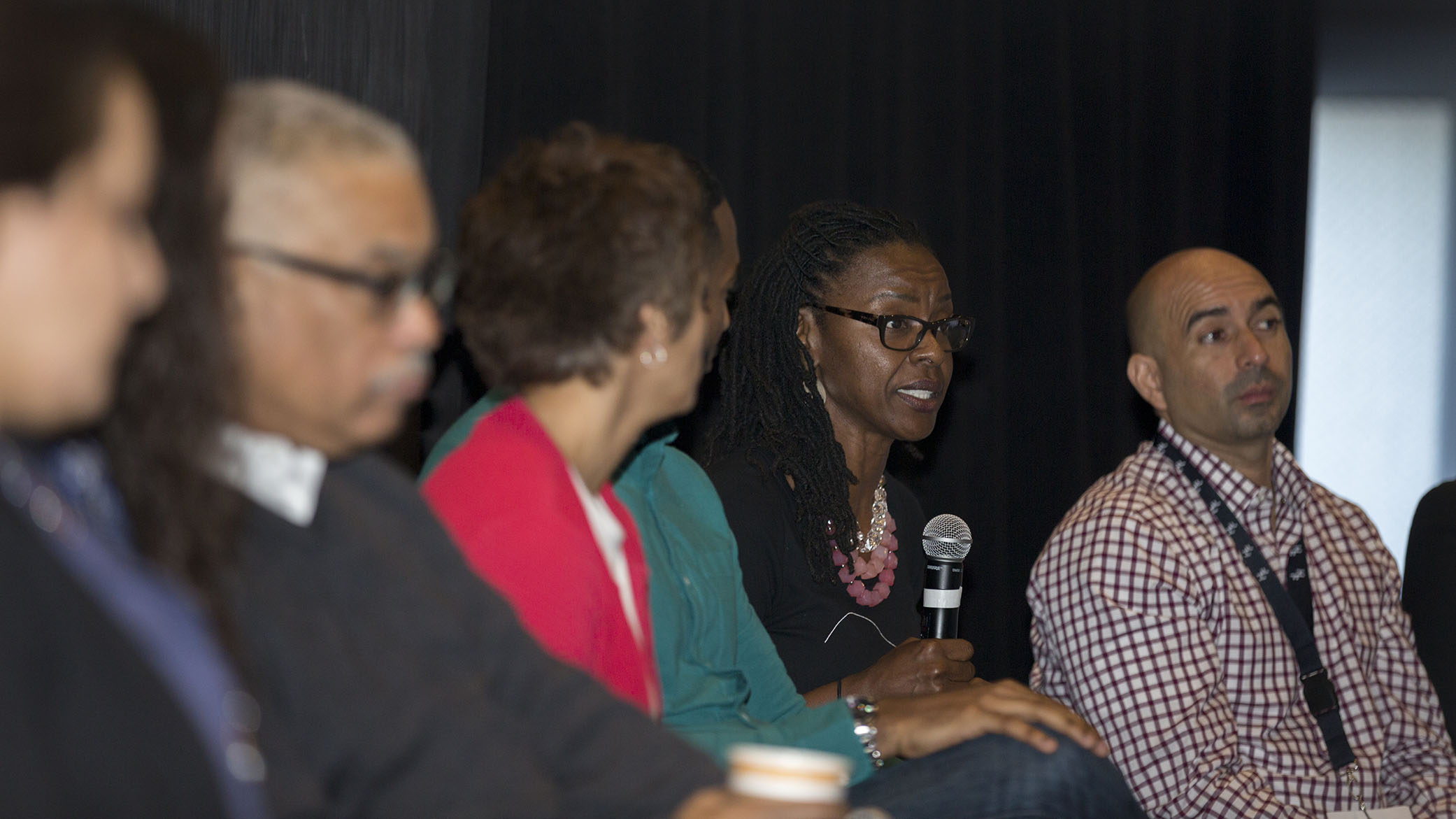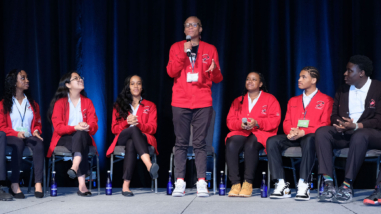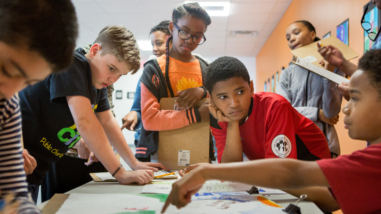How listening shaped our support of K-12 teaching and learning

Last year, our Education team engaged in an intensive, year-long strategy refresh for its K-12 Teaching and Learning work, known formerly as the Deeper Learning strategy. The process affirmed our work in some areas, forced healthy questioning in others, and brought us into contact with a broad array of new friends and fresh ideas. Strategy Officer Lori Grange, who works with Program teams to review and refine their strategies and helped with the K-12 refresh, spoke with Education Program Officer Charmaine Mercer about the process and how it’s impacted their new strategy.
Listen to the interview or read an edited transcript of their conversation below.
LORI: Charmaine, you and your teammates in the Education Program have had quite a wild ride over the last 18 months! You took a big step back to refresh the program’s Deeper Learning strategy, which first launched back in 2010. How did it go?
CHARMAINE: It’s still going, Lori! The Education team started the refresh journey in January 2018, a few months after I arrived at Hewlett. We set out to capitalize on the gains made from the prior strategy’s effort to accelerate important changes to the education ecosystem, including shifting the nation’s assessment system from one focused on circling the correct, pre-scripted response, to one requiring students to demonstrate their knowledge by writing and doing oral presentations. The prior strategy also introduced the importance of personalized education that places each student and their needs at the center of teaching and learning efforts, rather than treating children as interchangeable widgets. And most notably, the prior strategy was hugely successful in helping to create numerous schools, serving diverse populations of children in different contexts and settings, as a way of demonstrating that deeper learning was truly possible for all children.
Our new K-12 Teaching and Learning strategy seeks to build upon this by supporting communities in redesigning their education systems to ensure teaching and learning opportunities that prepare students to be engaged and thrive in the 21st century are equitably accessible. The strategy maintains a national focus while incorporating a handful of places throughout the nation where we will provide support across a greater number of areas. We are in the early stages of identifying places and will share publicly once those have been chosen.
Early on in the refresh process, including in our selection of places, we made a commitment to listen to the opinions and ideas of individuals and groups representing the cadre of voices along the education reform spectrum. This has included engaging more than 200 grantees in the Education team’s portfolio, visiting schools, meeting with superintendents, and many more. You can see who the team met with and read more about what we heard here. So, I guess I would say we’ve been on a wild ride! But we learned a lot, so it was well worth it.
LORI: That’s a great example of the foundation’s commitment to listening to others—how to do more of it, and better. (Hewlett’s website has a lot more information.)
In reflecting on my work with programs, asking for—and listening to—feedback is an important part of how we do strategy refreshes. Teams like yours revisit their strategies every five years or so. They learn, reflect, and adapt all along the way, but a refresh is comprehensive. It’s also demanding, as you well know! The stakes are high for us, our partners, and the field, so we try to be as rigorous and thoughtful as we can. Fortunately, our institutional guidance, Outcome-Focused Philanthropy, provides some method to the refresh madness.
In working with your program and other teams on refreshes over the last several years, I’ve seen that outreach to different stakeholders is one of the greatest determinants of success. Doing that well requires more than time and effort. It takes appetite—being eager to listen to people outside our walls, including and especially those who we hope will benefit from our work. It takes creativity, as your team showed in the ways you reached people. I loved the #HewlettListens Twitter Chat! And it takes a commitment to use what we learn to inform what we do moving forward. It’s listening, learning, and acting.
CHARMAINE: Yes, that’s exactly right. It also means being purposeful about finding those who do not agree with us or who have been previously overlooked, in terms of hearing their opinion or getting their responses to the work we were doing. As you know, our president, Larry Kramer, wrote a great piece about “listening with empathy.” At the very beginning of the process, we invited leaders of the civil rights and social justice policy and advocacy communities and asked them to share their thoughts and opinions about our work. Most of the organizations in the room were not grantees of Hewlett at the time and still accepted our invitation. They shared, and we listened. See the blog post on collecting ideas and insights for more details about the conversation, but it was a really rich conversation where we got tons of feedback about how philanthropy can show up inside of places and listen to voices that are different than the ones that they haven’t traditionally heard from. These conversations can be challenging. To listen to people who disagree with you or to listen to people who you might have overlooked in the past—there is a part of that process that you have to reflect on and own. In one meeting, a colleague from the civil rights and social justice community rhetorically asked, “are you implying that we support shallow learning?” She responded to us in this manner to signal that simply because our policy priorities did not align with their priorities, it did not mean that they did not want and value deep and engaging learning experiences for children. So hearing that and really listening for what that meant and not acting superficially is really important in the process of listening.
LORI: That’s huge, and I can hear what you’re saying about how challenging and difficult those kinds of conversations are but so critical. What other takeaways did you have from those conversations?
CHARMAINE: We wanted to find opportunities to listen and share as a team. We also tried to be thoughtful about when we should talk directly with individuals and groups and when our strategy consulting firm should do that on their own. And we built listening and learning into our new strategy as an ongoing part of our work. We thought that rather than waiting for 3-5 years and then going out and finding a group of people who we hadn’t listened to or had ignored, we would find opportunities to continue to do that throughout our new strategy process. That’s critical for this to succeed.
LORI: What are a few examples of how the listening and learning you’ve done so far takes shape in the new strategy?
CHARMAINE: As I previously mentioned, we listened to a lot of stakeholders, including parents, civil rights leaders, teachers, and superintendents. Based on what we heard, we are shifting our attention toward more purposeful and intensive training and support of teachers, supporting a national conversation about teaching and learning, making sure that we bring in new voices inside of those conversations, as well as understanding how to reimagine school districts so that high-quality learner-centric education is the product from those systems.
LORI: Your team did an enormous amount of listening. In my work with programs on refreshes, I’ve seen that it’s possible to go overboard. There’s a risk of collecting far more information than we’re able to use efficiently and effectively—and wasting the valuable time of those who contributed. Did your team strike the right balance? And how did you manage what must have been a firehose of information?
CHARMAINE: That was a REAL concern for the entire team at the beginning of the process. You can quickly find yourself wanting more information than you can realistically consume. At the very beginning, the team decided we would prioritize the questions we needed to have answered to move forward. During the refresh, we organized the topics and issues we wanted to examine and the types of stakeholders and organizations we wanted to listen to, determined the best means by which to do so, and scheduled accordingly. Admittedly, knowing we had to complete the process and present it to the board did provide some guardrails around unlimited fact-finding efforts. We also wanted to be mindful of the time and effort that our grantees, partners, and others made to prepare and provide us with information and feedback.
LORI: Another challenge to listening is the power dynamic between the foundation and current and potential grantees. It’s always in play during a refresh, even with our best intentions. How did your team help people feel comfortable telling it to you straight? And how did you develop your own comfort level for hearing the bad along with the good?
CHARMAINE: The power dynamic is real and must be acknowledged, and so we always do. For instance, our Program Director Kent McGuire and I convened a small group of trusted partners, which included two people from organizations we provide funding to and another Bay Area funder, to give us honest and unfiltered feedback on the direction of the strategy. While we worked hard to ensure that both people felt comfortable sharing their thoughts with us as funders, we forgot about their relationship with our funder colleague. Once we realized it, we paused the conversation and discussed. Given the nature of the relationships we have with all three people it was a quick and painless conversation and allowed us to continue having an open conversation about strategy. We learned that it’s critically important to acknowledge the power dynamic early when you are trying to listen and learn, and then find solutions for how best to handle in the given situation.
The second question is one that I believe is ongoing and ever-changing because we remain in learning mode, which requires you to take the good and bad. I would argue that listening to the bad and trying to find what is good or right inside of it, is what will make the strategy better. On a personal note, “iron sharpens iron” was a phrase regularly used in my family as a child. It was often the response from my parents to a complaint from my siblings or me, about the difficulty or toughness of any given situation. So, I carry this mindset into most things I do. In this instance, “iron” is simply listening to the opinions of people who disagree with the strategy, something I am certain will ultimately sharpen and improve on what we do.
LORI: That’s good advice to end on: Listen to your parents. And to the wide range of people and organizations in the field whose perspectives are essential to our work. Thanks, Charmaine!
CHARMAINE: My mother will be glad to hear that! Thanks, Lori!



